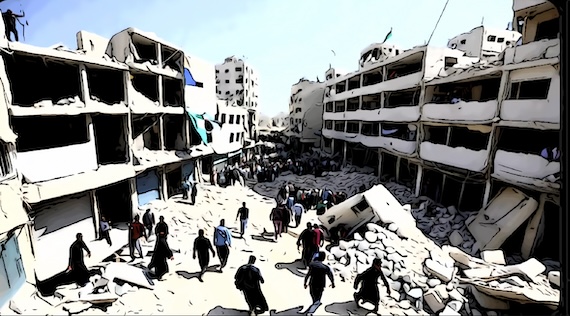( RFE/ RL) Muhammad Nasser’s life was torn apart after Hamas, the U.S.- and EU-designated Palestinian terrorist group, carried out an unprecedented attack on Israel one year ago.
Within hours of the October 7 attack that killed some 1,200 people, Israel launched one of the deadliest and most destructive bombing campaigns in modern history in the Palestinian enclave.
Nasser was a reporter working for local and international media outlets in Gaza City, the territory’s capital. But when Israeli forces launched a ground invasion of Gaza weeks later, he was forced to flee his home and drop his profession.
“We had to evacuate quickly and couldn’t take any personal belongings, not even clothes,” Nasser, who lived in the city of Beit Lahia, west of Gaza City, told RFE/RL’s Radio Farda. “I didn’t even have time to get into my car.”
Nasser, a father of six, has also lost members of his extended family in the yearlong war.
“My sister and all her children were killed,” said Nasser, adding they were taking shelter at a school run by the United Nations Relief and Works Agency (UNRWA) in northern Gaza when it was targeted by Israeli forces.
Israel’s war has taken a huge toll on civilians and infrastructure in Gaza, one of the most densely population areas in the world.
Over 41,000 Palestinians, most of them civilians, have been killed in Gaza since October 7, according to the Hamas-run Health Ministry. Israel has said it has killed around 17,000 Hamas fighters.
Israel’s Devastating War In Gaza In Numbers
More than 85 percent of Gaza’s residents, or over 1.9 million people, are internally displaced in the enclave, the UN estimates. Meanwhile, nearly the entire population of the Gaza Strip is facing starvation due to an extreme lack of food.

“Displacement,” Digital, Dream / Dreamland v3 / Clip2Comic, 2024
Nasser and his family have been constantly on the move to evade Israeli forces and air strikes. They now live in a tent in Al-Mawasi, a narrow strip of land along the Mediterranean Sea.
But even there, Nasser says he fears they will be targeted by Israeli warplanes, which have hit refugee camps, schools, and hospitals in the past year.
Israel said that it has targeted “terror” infrastructure and buildings in Gaza and has accused Hamas of using civilians as human shields.
“My children, my relatives, and I are in grave danger,” said Nasser. “Our relatives are scattered. We can’t even gather in one place to meet.”
He is not alone.
Hakeem, a civil engineer from Gaza City, has also been internally displaced.
“Our entire focus is on finding a safe place to take refuge,” the 41-year-old told Radio Farda. “Where is safer? Where can we get water? This is what our life has become.”
There is no end in sight to Israel’s war in Gaza, which has also killed at least 346 Israeli soldiers. Hamas has been militarily weakened but is still firing rockets on Israel from the strip.
Israel has expanded its war in recent weeks by invading Lebanon and launching air strikes targeting Hezbollah, the armed group and political party that controls much of southern Lebanon.
Despite the escalating violence engulfing the region, Hakeem hopes to one day return to his home in Gaza City.
“We dream of being able to rebuild our lives, return to the north, and regain the life we had before October 7,” said the father of four.
Written by Kian Sharifi based on reporting by Iliya Jazaeri of RFE/RL’s Radio Farda
Copyright (c)2024 RFE/RL, Inc. Used with the permission of Radio Free Europe/Radio Liberty
Via RFE/ RL


 © 2025 All Rights Reserved
© 2025 All Rights Reserved